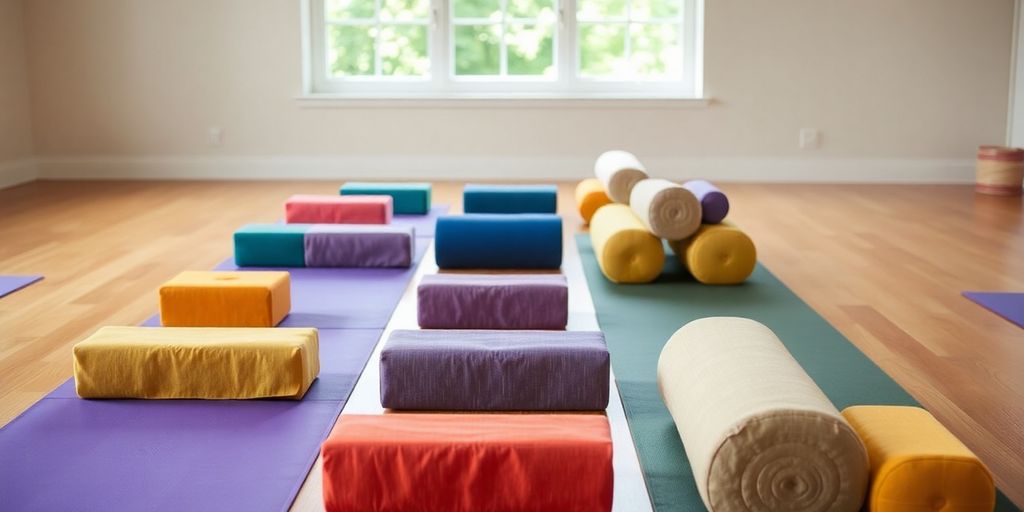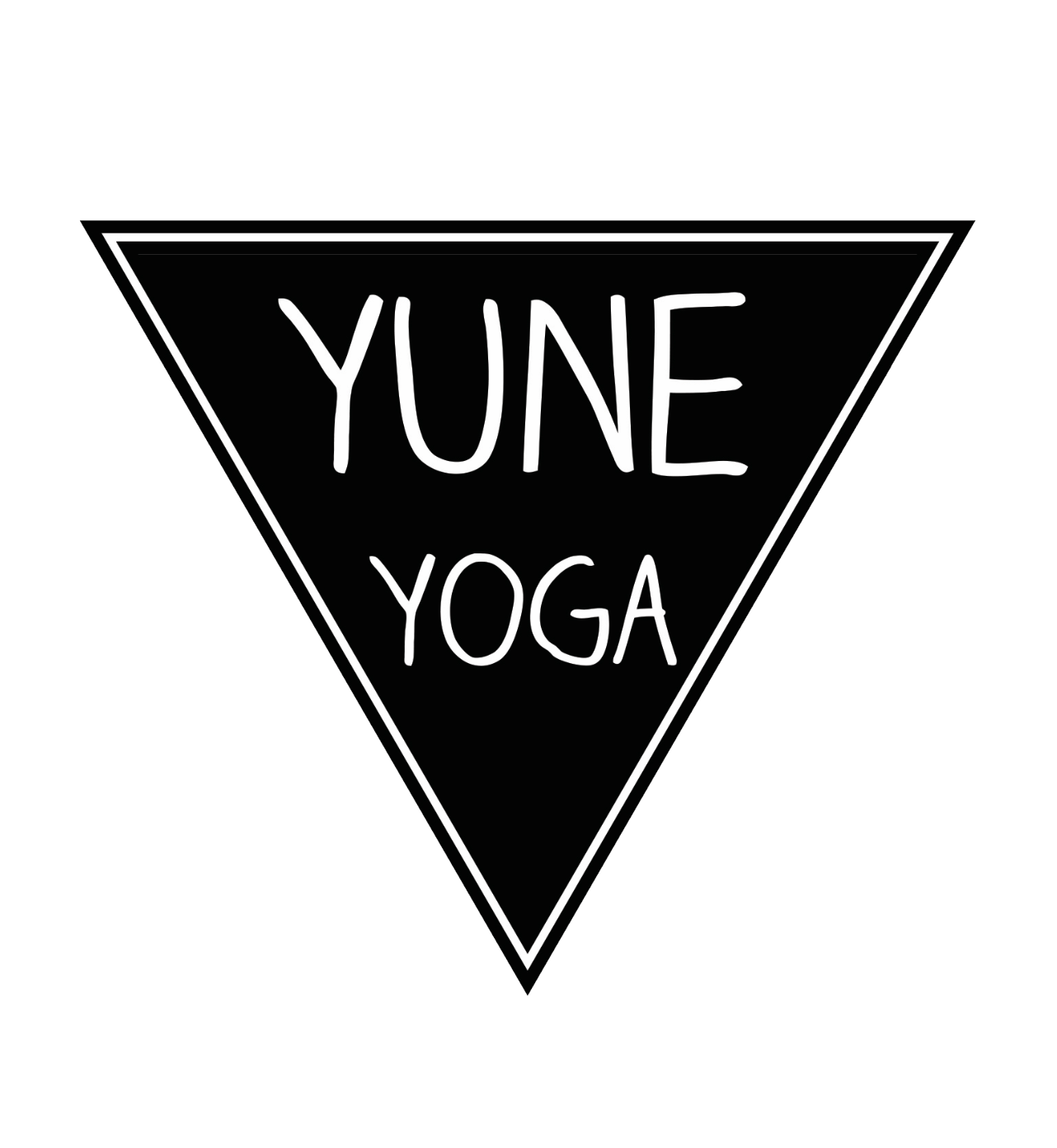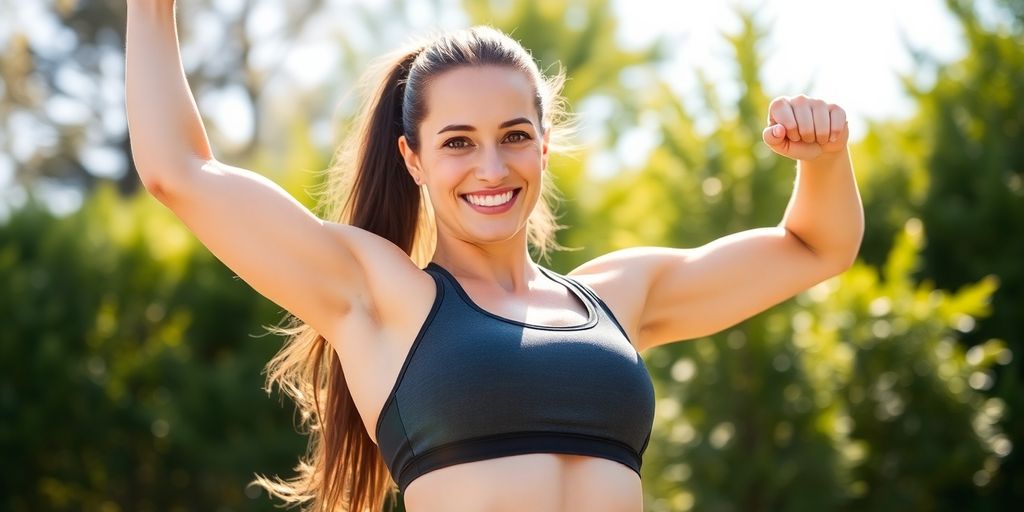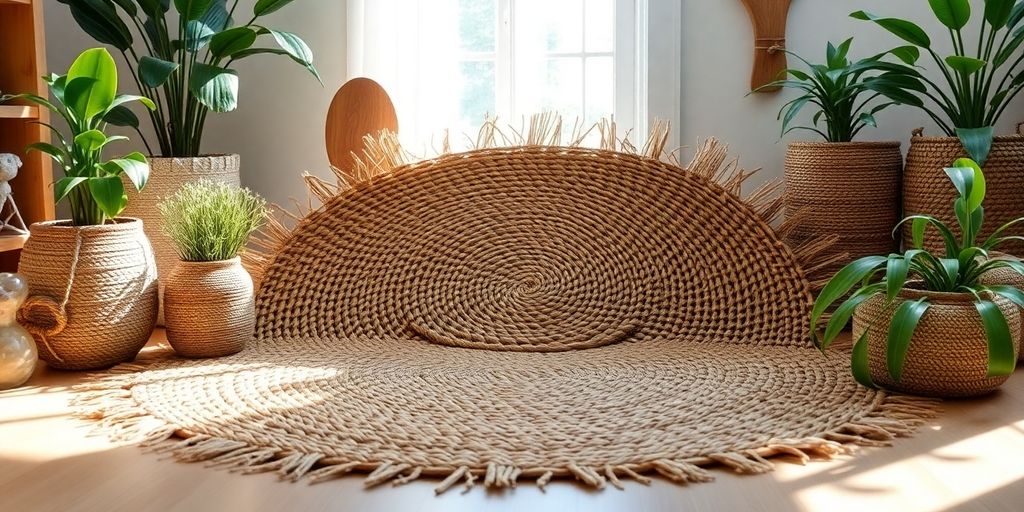
Essential Guide to Choosing the Right Yoga Block and Bolster for Your Practice
Choosing the right yoga block and bolster can really change your practice. These props not only provide support but also help you explore new depths in your poses. With so many options out there, it can feel overwhelming. This guide will help you figure out what you need to enhance your yoga experience, whether you're just starting out or looking to improve your skills.
Key Takeaways
- Finding the right bolster depends on your intended use and body type.
- Yoga blocks come in different materials like foam, cork, and wood, each serving unique purposes.
- Using props can improve your flexibility and alignment during practice.
- Check for quality and durability to ensure your yoga accessories last long.
- Consider your practice style when selecting yoga accessories for comfort and versatility.
Choosing The Right Bolster
Choosing the right bolster can really change your yoga practice. It's not just about grabbing any old pillow; it's about finding something that supports your body and helps you get the most out of each pose. There are a few things to think about to make sure you pick the perfect one for you.
Intended Use
What are you planning to use the bolster for? This is the first question you should ask yourself. Are you mainly into restorative yoga, or do you want something to help with your breathing exercises? Maybe you're looking for support during meditation. Different bolsters are designed for different purposes, so knowing what you need it for will help narrow down your choices.
Size
Size matters when it comes to bolsters. Think about your body size and the kind of support you need. A standard size might work for most people, but if you're taller or shorter, you might want to consider a larger or smaller bolster. You want something that feels comfortable and provides the right amount of support without being too bulky or too small. A standard cylindrical bolster is a good starting point for many.
Firmness
Bolsters come in different firmness levels, and the right one for you depends on your preferences. Some people like a firm bolster that gives a lot of support, while others prefer something softer and more comfortable for relaxing. If you're using it for poses that require a lot of support, like backbends, a firmer bolster might be better. For restorative poses, a softer one might be more comfortable. It's all about finding what feels best for your body.
Material
The material of your bolster is important for both comfort and durability. Look for bolsters made from high-quality, eco-friendly materials like organic cotton. Not only are these materials better for the environment, but they also tend to be more comfortable and last longer. Plus, they're often easier to clean and care for. Consider the yoga and meditation bolsters that align with your values.
Choosing the right bolster can really improve your yoga experience. It's about finding something that supports your body, enhances your practice, and helps you relax. Take your time, consider your needs, and don't be afraid to try out a few different options before making a decision.
Yoga Block Types
Yoga blocks are super useful tools in yoga, helping to modify poses and make them more accessible. They come in different materials, each with its own feel and benefits. Let's take a look at the main types you'll find.
Foam Blocks
Foam blocks are probably the most common type you'll see. They're lightweight, soft, and generally the most affordable option. This makes them a great choice for beginners or anyone who wants a gentler feel. However, they might not be as sturdy as other types, especially under a lot of weight. They can also compress over time, losing some of their support. If you're just starting out or need a block for restorative poses, foam is a solid choice. You can easily find yoga blocks in foam material.
Cork Blocks
Cork blocks offer a firmer feel compared to foam. They're made from the bark of cork trees, making them a more sustainable option. They provide excellent support and don't compress as easily as foam blocks. Cork blocks are also naturally antimicrobial, which is a nice bonus. They tend to be a bit more expensive than foam, but their durability and eco-friendly nature make them a worthwhile investment for many yogis. They're a good middle-ground option, offering both support and a comfortable feel.
Wooden Blocks
Wooden blocks are the sturdiest and heaviest of the bunch. They offer the most support and are great for poses where you need a really solid base. However, they're also the least forgiving – they don't have any give, so they might not be the best choice if you're looking for comfort. Wooden blocks are often made from bamboo or other hardwoods. They're the most expensive option and are typically preferred by experienced practitioners who need maximum stability. They are great for improving alignment in your practice.
Choosing the right yoga block really comes down to personal preference and what feels best for your body. Consider what you need the block for – is it for support, comfort, or stability? Try out different types if you can, and see which one suits your practice the best.
Benefits Of Using Yoga Props

Enhancing Flexibility
Yoga props can really help you get more flexible. It's not just about being able to touch your toes, it's about safely increasing your range of motion. Blocks, for example, can bring the floor closer to you in poses like triangle pose, allowing you to maintain proper alignment without straining. Straps can help you bind in poses where your hands don't quite reach. Over time, consistently using props can lead to noticeable improvements in your flexibility. It's a gradual process, but definitely worth it. Using yoga rings can also help deepen your stretches.
Improving Alignment
Proper alignment is key in yoga to prevent injuries and get the most out of each pose. Yoga props are super useful for achieving this. A block under your hand in half-moon pose can help you keep your spine straight and your hips aligned. A bolster under your knees in savasana can release tension in your lower back. These small adjustments can make a big difference in how you feel during and after your practice. It's all about finding that sweet spot where you're both challenged and supported.
Supporting Restorative Practices
Restorative yoga is all about relaxation and healing, and props are essential for creating that supportive environment. Bolsters are great for supported backbends or reclined poses, allowing you to completely relax and release tension. Blankets can be used to cushion joints or provide extra warmth. Eye pillows can block out light and help you sink deeper into relaxation. The goal is to create a space where your body feels completely supported, allowing you to fully let go and recharge. Essential yoga accessories for beginners can transform your practice.
Yoga is about finding your center and connecting with yourself. The right materials make this journey smoother and more enjoyable, turning each session into a rewarding experience.
Here's a quick list of how props can help:
- Bolsters: Provide support in reclined poses.
- Blocks: Help with alignment in standing poses.
- Straps: Assist in binding and reaching.
- Blankets: Cushion joints and provide warmth.
Testing For Quality And Durability
Material Considerations
When you're buying yoga blocks and bolsters, it's easy to get caught up in the colors and styles, but don't forget to think about what they're actually made of. The material impacts not only how the prop feels but also how long it will last. For example, a foam block might be comfy and cheap, but a cork block will probably hold up better over time. Same goes for bolsters – cotton filling might feel nice initially, but it could compress and lose its shape faster than a buckwheat hull filling. Think about how often you'll be using these things and what kind of wear and tear they'll be subjected to.
Construction Quality
Okay, so you've picked out a material. Now, take a closer look at how the thing is put together. Check the seams on bolsters – are they sturdy and well-stitched, or do you see loose threads already? With blocks, look for even edges and a smooth surface. Uneven surfaces or poorly glued pieces can mean the block won't be stable, and that's a recipe for disaster during a balancing pose. Give the prop a little squeeze and see if it holds its shape or if it feels like it's going to fall apart. Good construction is key to long-lasting yoga accessories.
Long-Term Use
Think about the long haul. Will that bolster still be supportive after a year of restorative yoga sessions? Will that block still have its shape after being tossed in your yoga bag a hundred times? Some materials just naturally hold up better. Cork and wood are pretty resilient for blocks, while bolsters with denser fillings like buckwheat tend to maintain their shape longer. Read reviews and see what other yogis say about how these props hold up over time. It's worth spending a bit more upfront for something that will last, rather than replacing cheap yoga blocks every few months.
It's a good idea to start with a few essential props and then add more as you get more into your practice. This way, you can really figure out what you need and what works best for you without spending a ton of money on stuff you might not use.
Tips For Selecting Yoga Accessories Based On Your Needs
Assessing Your Practice Style
Choosing the right yoga accessories really starts with understanding what kind of yoga you like to do and what you're hoping to get out of it. Are you all about that chill, restorative vibe, or do you prefer something more intense that gets you sweating? Knowing this helps you pick accessories that actually fit your needs. For example, if you're trying to get more flexible, maybe yoga rings would be a good fit. Or, if you're working on your balance, toe separators might be the way to go.
Prioritizing Comfort
When you're picking out yoga props, comfort is key. You want stuff that feels good to use and doesn't distract you from your practice. Think about it: if your block is digging into your hands or your bolster is too hard, you're not going to be able to relax and focus. Look for accessories that can do more than one thing across different yoga styles. For example, bolsters are great for restorative poses, but you can also use them when you're meditating. Blocks are also super useful; they can help you balance in standing poses and deepen your stretches. Always make sure the accessories feel good to you; they should feel like they're part of your practice, not something that's getting in the way.
Versatility Across Styles
It's a good idea to think about how versatile your yoga gear is. Can you use it for different types of yoga, or is it only good for one thing? Getting stuff that you can use in lots of different ways is a smart move. Here are some things to keep in mind:
- Blocks: Great for all sorts of poses, from standing to seated.
- Straps: Perfect for improving your reach and flexibility.
- Bolsters: Ideal for restorative yoga and meditation.
Start simple and add more as you go. This way, you don't end up buying a bunch of stuff you don't need, and you can make sure each accessory really helps you with your yoga journey.
Where To Buy High-Quality Yoga Material
When you're ready to invest in some quality yoga gear, you've basically got two main paths to explore: the vast world of online shopping and the more personal experience of local stores. Both have their perks, so let's break it down.
Online Shopping Options
Online shopping offers unmatched convenience. You can browse a huge selection of eco-friendly yoga accessories from the comfort of your home, compare prices easily, and often find deals you wouldn't see in a brick-and-mortar store. Plus, many online retailers specialize in yoga gear, giving you access to a wider range of specialized items. Just be sure to read reviews carefully before you buy!
- Huge selection of products
- Easy price comparison
- Convenient shopping from home
Local Yoga Stores
Stepping into a local yoga store gives you something online shopping can't: the ability to touch, feel, and test the products before you buy. This is especially important when it comes to things like yoga mats and bolsters, where texture and firmness matter. You can also get personalized advice from staff who are often experienced yogis themselves. Plus, you're supporting a local business!
Shopping locally can also build a sense of community. You might even run into your favorite yoga instructor while browsing!
Eco-Friendly Brands
If you're passionate about sustainability, seeking out eco-friendly brands is a must. Look for companies that use sustainable materials like organic cotton, recycled rubber, or cork. These brands often prioritize ethical manufacturing practices as well, ensuring that your purchase aligns with your values. Investing in durable yoga props from these brands is a win-win for you and the planet.
- Sustainable materials
- Ethical manufacturing
- Reduced environmental impact
Integrating Yoga Blocks And Bolsters Into Your Practice

Using Blocks For Balance
Yoga blocks are super useful for improving your balance in different poses. If you're struggling with poses like half-moon or warrior three, placing a block under your hand can provide that extra bit of support you need. It's not about cheating; it's about building strength and stability over time. Think of it as training wheels for your yoga practice. As you get stronger, you can gradually reduce your reliance on the block.
- Start with the block at its highest setting.
- As you improve, lower the block to medium, then low.
- Eventually, try the pose without the block.
Incorporating Bolsters In Restorative Poses
Bolsters are like big, soft pillows designed to make restorative yoga even more relaxing. They provide support that allows your muscles to completely relax, which is the whole point of restorative yoga. For example, in a supported child's pose, placing a bolster between your thighs and chest can ease tension in your lower back. Or, in a supported backbend, a bolster under your spine can gently open your chest and shoulders. It's all about finding what feels good and allows you to release stress. A yoga bolster is a great addition to your practice.
Combining Both For Enhanced Support
Using blocks and bolsters together can really take your yoga practice to the next level. The combination allows for deeper stretches and more comfortable poses. For example, in a seated forward fold, you can place a block under your forehead for support and a bolster under your knees to ease hamstring tension. This way, you're not forcing anything; you're simply allowing your body to open up at its own pace. It's a great way to modify poses to suit your individual needs and limitations.
It's important to listen to your body and not push yourself too hard. Yoga is about finding balance and ease, not about achieving some perfect pose. Using props like blocks and bolsters can help you find that balance and ease, making your practice more enjoyable and sustainable in the long run.
Wrapping It Up
In the end, picking the right yoga block and bolster can really change how you practice. Think about what you need and how you like to move. A good block can help you reach further and feel more stable, while a bolster can make your restorative poses way more comfy. Don’t rush the decision—try out a few options to see what feels best for you. Remember, these props should support your journey, not complicate it. So, take your time, listen to your body, and enjoy the process of finding the perfect gear for your yoga practice.
Frequently Asked Questions
What is a yoga bolster used for?
A yoga bolster is used to provide support and comfort during yoga poses, especially in restorative practices and meditation.
How do I choose the right size bolster?
The right size bolster depends on your body size and the type of support you need. Standard sizes work for most people, but you might need a smaller or larger one.
What types of materials are best for yoga blocks?
Yoga blocks can be made from foam, cork, or wood. Foam blocks are light and soft, cork blocks are sturdy and eco-friendly, and wooden blocks are very durable.
Can yoga props help beginners?
Yes! Yoga props like blocks and bolsters make poses easier and help beginners feel more comfortable and supported.
How do I know if a yoga bolster is firm enough?
Try it out! A good bolster should feel supportive but still comfortable. It shouldn't be too hard or too soft for your needs.
Where can I find quality yoga accessories?
You can find quality yoga accessories online, at local yoga stores, or from eco-friendly brands that focus on sustainable materials.


